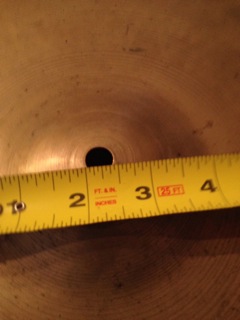
This change is associated with a shift in the size of the top of cymbal stands from 6 mm (1/4") to 8 mm (5/16"). These measurements are approximate. If you have smaller posts then you can use either older or newer cymbals. If you have the larger posts on your cymbal stands then you may have trouble with older cymbals being too tight a fit once you also put a plastic protector in place.
Image: The 7/16" Mounting Hole

The above cymbal in one which shows a nicely preserved small mounting hole. You have to look closely because the difference is only 1/16", but it becomes very significant when your vintage cymbal doesn't fit on a cymbal stand. This picture is of a 1940s Trans Stamp so it is from some years before the change. The problem is that in many cases cymbals with the smaller hole have had that hole enlarged to fit modern cymbal stands. There are two possible outcomes when a smaller hole gets enlarged.
The first outcome is that the hole may be drilled out carefully using a 1/2" bit and drill press so neatly that we cannot see that the hole has been modified. Machine hole modification.
The second outcome is that a hole can be enlarged but the method which is used leaves traces. In this case it is still possible to tell that the hole has been enlarged after the fact. "Handmade" enlarged holes can lead to holes which are out of round, have scolloped edges, possibly triangular instead of round, and a bit worn looking all around. This looks different from a clean hole which also has keyhole. The techniques for enlarging holes which might leave these sorts of traces are: using a small rat tail file, or a hole reamer, or similar tool. Pretty much anything which is hand held and hand powered. We vintage cymbal enthusiasts may love our "hand hammered" cymbals and claim to be able to tell "machine made" from "handmade". Hole enlarging is a situation where a "handmade" enlarged hole may be similarly identified.
Image: Enlarged triangular mounting hole
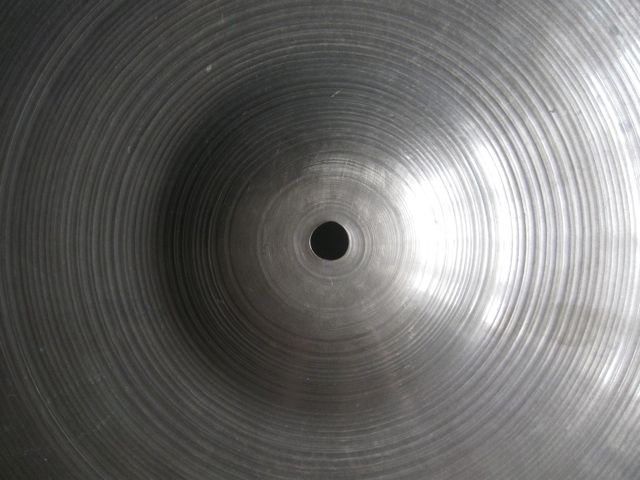
The above picture is an example of a Trans Stamp from the mid 1950s and the mounting hole shows the triangular shape of a "handmade" enlargement. This is my cymbal and although it fits on a modern cymbal stand it isn't a full sized 1/2" hole. I have a number of 1950s and earlier cymbals in my collection which fit modern stands and I never took much notice. But now I do. And my method for spotting "handmade" enlarged holes is to nest a modern 1/2" hole cymbal on top of the bell of an older cymbal. That makes it easy to spot the difference.
Image: Out of round mounting hole

The above example is a mounting hole which illustrates the uneven wear we've described. However, at this point we don't know if it is just a very worn hole which started off at 1/2", or a "handmade" enlarged hole. Deciding that for a particular cymbal is down to what else you know about the age of the cymbal. There is still the possibility that a hole which started out life as 1/2" starts to look like it has been enlarged because the cymbal has a lot of wear and tear (playing time) on the stand -- possibly without proper plastic protectors to save it rubbing straight on the metal post of the stand. As the mounting hole shown above is over 1/2", it is just a very worn originally 1/2" hole. It does come from a 1960s cymbal and should have started out with a 1/2" hole. Thanks Tom, for the photos and measuring.
In terms of dating cymbals from the hole size the information is not symmetric. If the hole is 1/2" and clean that tells you nothing about the likely manufacture date. If the hole is 7/16" then the cymbal should be 1957 or earlier. And if the cymbal has an out of round hole that looks like it was enlarged, or a hole which is smaller than 1/2" then it should be 1957 or earlier.
In terms of confirming the 1958 changeover year, the situation is that there should be few cymbals from before the Late 50s Small Stamp period that have perfectly formed 1/2" holes. Those ones we can't be sure about. Within the Late 50s Small Stamp cymbals themselves some might have perfectly formed 1/2" holes and others might not. And 1960s cymbals onwards should all have well formed 1/2" mounting holes. So there is a specific prediction about the pattern we expect to find, but it won't be a 100% perfect correlation. That's what is reported so far, although as we gather larger sample sizes things may change.
It wouldn't be wise to use only hole size to estimate the age of a cymbal, but it is perfectly reasonable to add the information of a small hole into the mix of things you consider. Check the stamp, the lathing, the visible hammering, and everything else possible. But a small hole size may also help add weight to your evidence that a cymbal is older.
Keyhole is called keyhole because as that worn part (heading off to the right) gets longer and longer, the mounting hole begins to look more like the keyhole in a door. Sideways in this example, but you should get the idea.

The keyhole shown above is also interesting because of the degree of roughness along the extended portion to the right. The edges aren't smooth at all. I don't know if that indicates that the keyhole got there by unprotected use and the post on the cymbal stand did it while it was bouncing around. Or perhaps it is a sign that somebody made the keyhole very crudely with a rat tailed file. Some drummers are said to have put a keyhole into their cymbals on purpose so that the cymbal sits the same way and tilts at the angle they prefer.
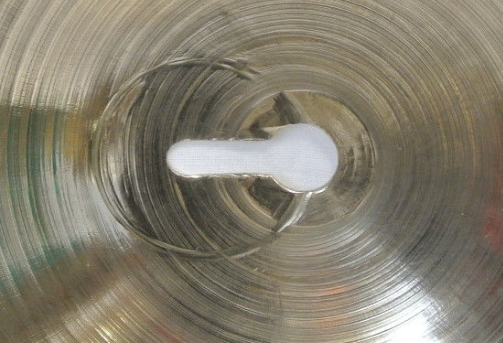
The above example shows that the keyhole on this cymbal did cause it to sit at the end of the keyhole and that would give it tilt. That doesn't prove it was keyholed first to achieve that end. But it does provide a cautionary note about not using felts. The serious ring of wear centered on the end of the keyhole is the result of lots of playing on an "old school" metal washer with no felt to protect the bronze cymbal from the harder steel washer. Please use felts.

The image above shows another of my cymbals. This one has what I code as "slight keyhole". This isn't bad for a 50 year old cymbal. I draw the line between "slight keyhole" and "bad keyhole" at the point where the tail portion is half as long as the diameter of the hole. If this one gets 2 mm longer it would shift to being "bad keyhole". As the following one has done:
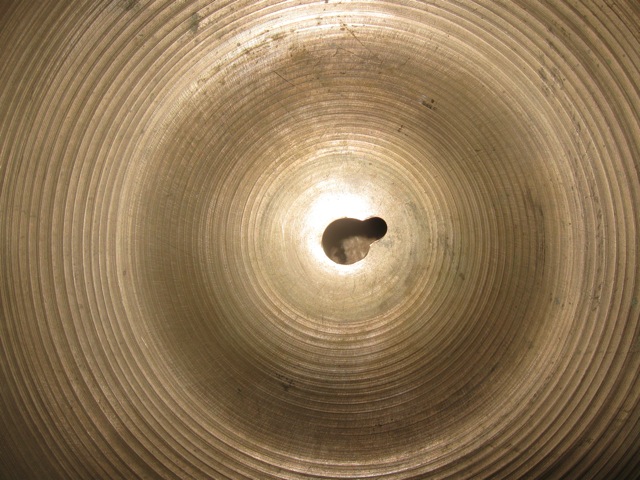
This keyhole (which would also be coded as "bad" in my pricing research) was most likely done on a cymbal stand with a smaller (6 mm) post. How can we tell? If you put it on a stand with an 8 mm post it doesn't fit over the post.

You can see how the mounting hole sits awkwardly and the post cannot slide into the keyhole portion. In contrast, when placed on a 6mm post it fits like a glove:
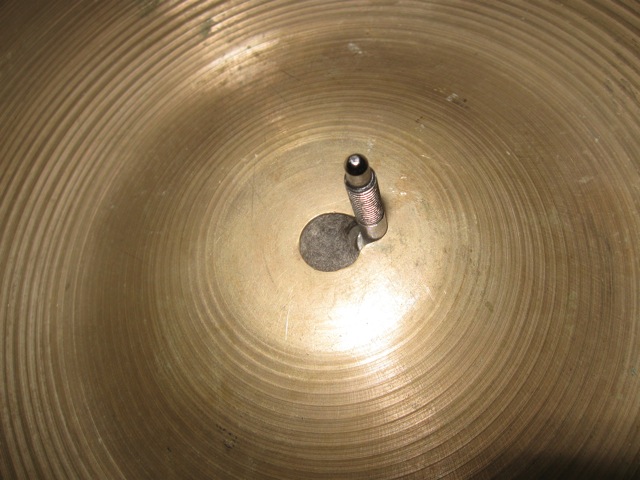
So I suspect that the keyhole was made by an "old school" 6mm post through use without a plastic protector. An alternative explanation is that it was done by some other means but to fit an "old school" 6mm post. But it really doesn't look like it can relate to an 8mm post. So even the keyhole on a cymbal may tell us something of the history of use experienced by a cymbal.
or back to the introduction page
text last updated 9 Jan 2016 6:17 PM

This work is licensed under a Creative Commons Attribution-ShareAlike 4.0 International License.